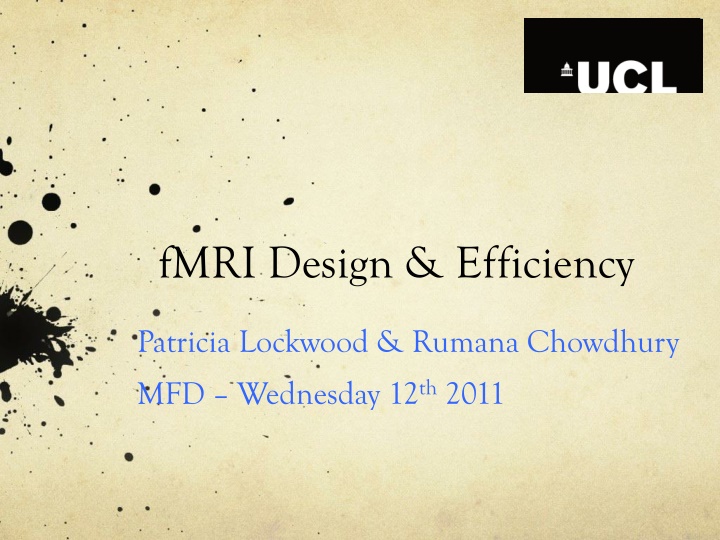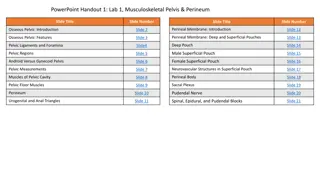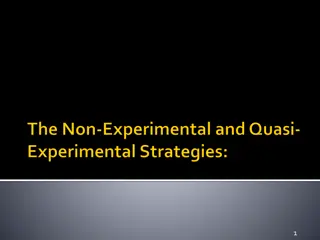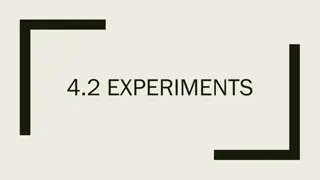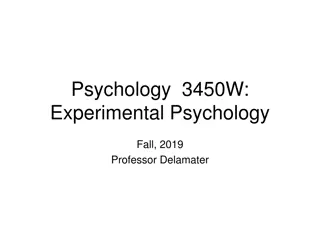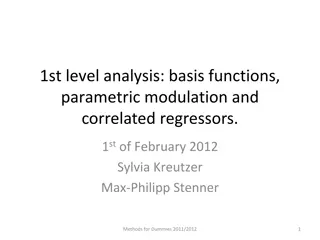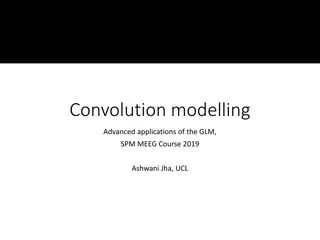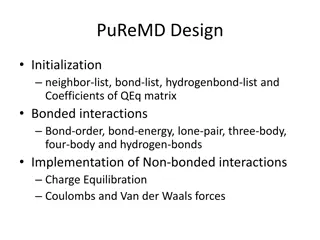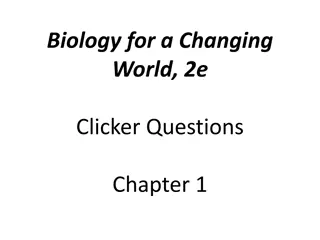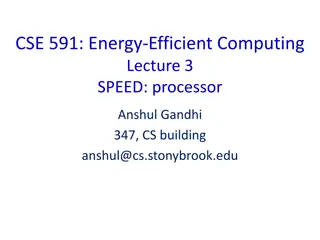Efficient fMRI Experimental Design: Maximizing Neurovascular Response
Understanding the importance of correctly designing fMRI experiments is crucial for testing specific hypotheses by manipulating stimulus types, timing, and participant instructions. Types of experimental designs include categorical, factorial, and parametric designs, each serving different purposes in analyzing brain responses. A well-designed experiment ensures optimal efficiency and accuracy in interpreting neuroimaging data.
Download Presentation

Please find below an Image/Link to download the presentation.
The content on the website is provided AS IS for your information and personal use only. It may not be sold, licensed, or shared on other websites without obtaining consent from the author.If you encounter any issues during the download, it is possible that the publisher has removed the file from their server.
You are allowed to download the files provided on this website for personal or commercial use, subject to the condition that they are used lawfully. All files are the property of their respective owners.
The content on the website is provided AS IS for your information and personal use only. It may not be sold, licensed, or shared on other websites without obtaining consent from the author.
E N D
Presentation Transcript
fMRI Design & Efficiency Patricia Lockwood & Rumana Chowdhury MFD Wednesday 12th2011
Overview Experimental Design Types of Experimental Design Timing parameters Blocked and Event-Related & Mixed design
Main take home message of experimental design Make sure you ve chosen your analysis method and contrasts before you start your experiment!
Why is it so important to correctly design your experiment? Main design goal: To test specific hypotheses We want to manipulate the participants experience and behaviour in some way that is likely to produce a functionally specific neurovascular response. What can we manipulate? Stimulus type and properties Stimulus timing Participant instructions
Types of experimental design Categorical - comparing the activity between stimulus types 1. Factorial - combining two or more factors within a task and looking at the effect of one factor on the response to other factor 2. Parametric - exploring systematic changes in brain responses according to some performance attributes of the task 3.
Categorical Design Categorical design: comparing the activity between stimulus types Example: Stimulus: visual presentation of 12 common nouns. Tasks: decide for each noun whether it refers to an animate or inanimate object. goat bucket
Factorial design combining two or more factors within a task and looking at the effect of one factor on the response to other factor MOTION NO MOTION Simple main effects A B e.g. A-B = Simple main effect of motion (vs. no motion) in the context of low load LOW LOAD Main effects e.g. (A + B) (C + D) = the main effect of low load (vs. high load) irrelevant of motion C D HIGH Interaction terms e.g. (A - B) (C D) = the interaction effect of motion (vs. no motion) greater under low (vs. high) load
Factorial design in SPM Main effect of low load: A B C D (A + B) (C + D) [1 1 -1 -1] Simple main effect of motion in the context of low load: A B C D [1 -1 0 0] (A B) Interaction term of motion greater under low load: A B C D [1 -1 -1 1] (A B) (C D)
Parametric design = exploring systematic changes in brain responses according to some performance attributes of the task Parametric designs use continuous rather than categorical design. For example, we could correlate RTs with brain activity.
Overview Experimental Design Types of Experimental Design Timing parameters Blocked, Event-Related & Mixed Design
Experimental design based on the BOLD signal A brief burst of neural activity corresponding to presentation of a short discrete stimulus or event will produce a more gradual BOLD response lasting about 15sec. Due to noisiness of the BOLD signal multiple repetitions of each condition are required in order to achieve sufficient reliability and statistical power.
Blocked design = trial of another type (e.g., place image) = trial of one type (e.g., face image) Multiple repetitions from a given experimental condition are strung together in a condition block which alternates between one or more condition blocks or control blocks
Advantages and considerations in Block design The BOLD signal from multiple repetitions is additive Blocked designs remain the most statistically powerful designs for fMRI experiments (Bandetti & Cox, 2000) Can look at resting baseline e.g Johnstone & colleagues Each block should be about 16-40sec Disadvantages Although block designs are more statistically efficient event related designs often necessary in experimental conditions Habituation effects In affective sciences their may be cumulative effects of emotional or social stimuli on participants moods
Event related design time In an event related design, presentations of trials from different experimental conditions are interspersed in a randomised order, rather then being blocked together by condition In order to control for possible overlapping BOLD signal responses to stimuli and to reduce the time needed for an experiment you can introduce jittering (i.e. use variable length ITI s)
Advantages and considerations in Event-related design Avoids the problems of habituation and expectation Allows subsequent analysis on a trial by trial basis, using behavioural measures such as judgment time, subjective reports or physiological responses to correlate with BOLD Using jittered ITIs and randomised event order can increase statistical power Disadvantages More complex design and analysis (esp. timing and baseline issues). Generally have reduced statistical power May be unsuitable when conditions have large switching cost
Mixed designs More recently, researchers have recognised the need to take into account two distinct types of neural processes during fMRI tasks 1 sustained activity throughout task ( sustained activity ) e.g. taking exams 2 brain activity evoked by each trial of a task ( transient activity ) Mixed designs can dissociate these transient and sustained events (but this is actually quite hard!)
Study design and efficiency Part 2 Rumana Chowdhury
Background: terminology Trials: replication of a condition Trial may consist of events (burst of neural activity) or epochs (sustained neural activity) ITI: time between onset of successive trials SOA (stimulus onset asynchrony): time between the onset of components
Background: General Linear Model x Y = X +E Matrix of BOLD signals Design matrix Matrix parameters Error matrix (What you collect) (This is what is put into SPM) (These need to be estimated) (residual error for each voxel) Time Time Time Regressors Voxels Voxels Voxels Regressors
Background: BOLD impulse response A BOLD response to an impulse (brief burst) of activity typically has the following characteristics: - A peak occurring at 4-6s - Followed by an undershoot from approximately 10-30s
Predicted response To obtain predicted fMRI time series: Convolve stimulus with the haemodynamic response PREDICTED ACTIVATION IN VISUAL AREA PREDICTED ACTIVATION IN OBJECT AREA BOXCAR CONVOLVED WITH HRF [From fMRI for newbies]
Fixed SOA 16s Fixed SOA 4s: low variance, lose stimulus energy after filtering
Random SOA minimum 4s e.g. event-related: larger variability in signal Blocked, SOA 4s: larger variability in signal
Fourier transform Operation that decomposes a signal into its constituent frequencies [ from XKCD]
High pass filter fMRI noise tends to have two components: Low frequency 1/f noise e.g. physical (scanner drifts); physiological [cardiac (~1 Hz); respiratory (~0.25 Hz)] Background white noise SPM uses a highpass filter to maximise the loss of noise & minimise the loss of signal. Apply highpass filter to the lowpass filter inherent in the IR to create a single band-pass filter (or effective HRF ).
Here fundamental frequency is lower than highpass cutoff so most is lost i.e. make sure block length is not too long (16s on, 16s off is optimal)
Randomised SOA some low and high frequency lost but majority is passed i.e. this is a reasonable design
Efficiency equation General Linear Model: Y = X . + Data Design Matrix Parameters error Efficiency is the ability to estimate , given your design matrix (X) for a particular contrast (c) e (c, X) = inverse ( 2 cT Inverse(XTX) c) All we can alter in this equation is c and X
Timing Differential Effect (A-B) With randomised designs, optimal SOA for differential effect (A-B) is minimal SOA (>2 seconds, and assuming no saturation), whereas optimal SOA for main effect (A+B) is 16-20s Common Effect (A+B) 4s smoothing; 1/60s highpass filtering
Timing: sampling & jitter Jitter can also be used to introduce null events Efficient for differential and main effects at short SOA
Conclusions From Rik Henson: Do not contrast conditions that are far apart in time (because of low- frequency noise in the data). 1. Randomize the order, or randomize the SOA, of conditions that are close in time. 2. Also: Blocked designs generally most efficient (with short SOAs, given optimal block length is not exceeded) Think about both your study design and contrasts before you start!
References http://imaging.mrc- cbu.cam.ac.uk/imaging/DesignEfficiency Harmon-Jones, E. y Beer, J. S. (Eds.) (2009). Methods in social neuroscience. Nueva York: The Guilford Press. Johnstone T et al., 2005. Neuroimage 25(4):1112-1123 Previous MfD slides Thanks to our expert Steve Flemming
